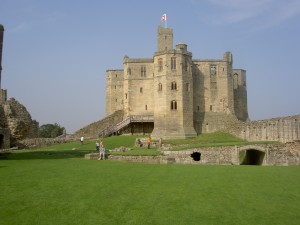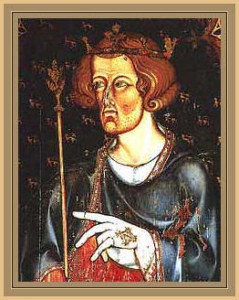
I’m trying something different with this blog post. It would seem that my original idea to write a snappy bite sized slice of history seems to have grown to be more of a rather bloated stodgy cake of history! I’m going to attempt a short Q & A of interesting facts about the Plantagenet’s. This is inspired by Derek Wilson’s brilliant A to Z of The Plantagenets in the November 2011 issue of BBC History Magazine.
Who were the Plantagenets?
The Plantagenet dynasty ruled England longer than any other royal family. Geoffrey of Anjou claimed the crowns of England and Normandy in right of his wife Matilda when Henry I died in 1135. Their son Henry was recognised as hair-apparent in 1154. The Plantagenets ruled until 1485 when Richard III, the last Plantagenet was defeated at the Battle of Bosworth Field by Henry Tudor who became Henry VII; the first Tudor Monarch.
What’s a Plantagenet?
In the twelfth century Geoffrey of Anjou wore a sprig of the common broom, known in Latin as the Planta genista in his hat. Plantagenet is a corruption of Geoffrey’s nickname Plantegenest or Plante Genest. Interestingly there is hardly any evidence of the name being used before the mid fifteenth century but has been applied retrospectively as a surname for all descendants of Geoffrey of Anjou. It’s suspected that the name was popularised by Shakespeare.
Who was Edward Longshanks?

Edward I of England
Edward longshanks was the nickname of Edward I who reigned from 1272 to 1307. Longshanks is a reference to Edwards tall stature and literally means “long legs” or “long shins”. On 2 May 1774, the Society of Antiquaries opened Edward’s tomb in Westminster Abbey. They reported that his body had been well preserved over the preceding 467 years, and measured the king’s body to be 6 feet 2 inches (188 cm). At this length, he would tower over most of his common contemporaries who would average around 5 feet 5 inches (170cm) in height.
How did the Wars of the Roses Start?
The Wars of the Roses was fought between two rival branches of the House of Plantagenet; the house of York and Lancaster. John of Gaunt (gaining his name from his birth place of Ghent) was the youngest son of Edward III. When Edward II died in 1377 he left his crown to his grandson Richard II, John became a leading political figure but courted controversy by attempting to separate the crown from the church. When John’s son Henry Bolingbroke rebelled against Richard II John initially supported the king but later switched alliances to support Bolingbroke’s claim to the throne sparking the Wars of the Roses.
Who Reigned The Longest?
Henry III ascended the throne in 1216 aged only 9 and reigned until his death in 1272; a total of 56 years. Henry spent extravagantly to emphasis the importance of the crown and the church. Henry extended Westminster Abby turning it into a shrine to Edward the Confessor and making it his seat of government. Henry spent much of his time fighting the baron s over the Magna Carta; a legacy from his father John.
Who was Revolting?
There were a number of revolts across medieval Europe during the Plantagenet reign. Perhaps the best known is the Peasants’ revolt of 1381 led by (among others) the articulate and violent Wat Tyler. The revolt was sparked by a combination of a heavy handed Poll Tax and a reduction in the labor force caused by the Black Death. Tax collectors attempted to collect the poll tax from villagers at Fobbing in Essex, the villages refused to pay and the tax collectors left empty handed. When Robert Belknap (Chief Justice of the Court of Common Pleas) arrived in Brentwood to investigate he was attacked. Violence spread and soon Essex and Kent were in full revolt. Soon after an armed uprising moved on London. Although the rebels that had gathered with Jack Straw were systematic with their violence the Kentish contingent led by Tyler embarked on an orgy of looting. The rebels dragged the Lord Chancellor (Simon of Sudbury, the Archbishop of Canterbury) and the Lord Treasurer (Robert de Hales, the Grand Prior of the Knights Hospitallers of England) from the Tower of London and executed them. Richard II rode out at Smit hfield to meet the rebels. The meeting did not go well, Tyler was ran through with a sword and mortally wounded, the king hastily arranged a militia of 7000 to pursue the rebel leaders and execute them. The revolt later came to be seen as a mark of the beginning of the end of serfdom in medieval England, although the revolt itself was a failure.
When Geoffrey and Matilda’s son Henry was recognised as hair-apparent in 1154 England was just one part of a loose confederation of states, most of which lay in what is now France. As the Barons started to identify more with their English estates they lost interest in foreign adventure and by 1485 only Calais remained. The plantagenets attempted to excerpt their rule successfully over Wales and unsuccessfully over Scotland, Parliament was established as a partner in government and Henry V won one of the most famous battles in English history ; Agincourt!
 I’m trying something different with this blog post. It would seem that my original idea to write a snappy bite sized slice of history seems to have grown to be more of a rather bloated stodgy cake of history! I’m going to attempt a short Q & A of interesting facts about the Plantagenet’s. This is inspired by Derek Wilson’s brilliant A to Z of The Plantagenets in the November 2011 issue of BBC History Magazine.
I’m trying something different with this blog post. It would seem that my original idea to write a snappy bite sized slice of history seems to have grown to be more of a rather bloated stodgy cake of history! I’m going to attempt a short Q & A of interesting facts about the Plantagenet’s. This is inspired by Derek Wilson’s brilliant A to Z of The Plantagenets in the November 2011 issue of BBC History Magazine. 

Would you be fascinated about exchanging hyperlinks?
Hi there, found your blog through Google, and found that it’s really informative.
Cheers!
Great blog you have here..
U have a awesome weblog over here. I just wanna thank you for all the interesting info on it. I’ll follow your weblog if you keep up the good work!
This is a cool blog! I think I’ll visit your website more if you post more of this kind of specific information. Thanks a lot for posting.
You have a cool site over here. I just wanna thank you for all the interesting stuff on it. I’ll follow your blog if you keep up the good work!
I am extremely impressed with your writing skills as well as with the layout on your weblog. Is this a paid theme or did you customize it yourself? Anyway keep up the quality writing, it’s rare to see a nice blog like this!
There’s certainly a great deal to find out about this subject.
Hi Kaitlin, I actually think of bipolar as a monster sometimes too. I have a visual for it in my head and can see it attacking me. I don’t think th728#&t1a;s a negative. Of course, beating yourself up for not being able to fight it off, that’s the bad bit.I would say, when you’re dealing with monsters, you should give yourself a break. You do fight – the best you can, and that’s enough.- Natasha
Rejuvenated web work:
http://melinda.w.telrock.org
New net invent:
http://nona.go.telrock.net
справка 086 купить – купить медсправку для замены прав, справка 086
try this website kjope falske penger for minibanker
cryptocurrency exchange rates switchain – best cryptocurrency exchange instaswap, exchange coinswitch
visit homepage https://1xslots-casino.site
Getty Images6Torino presdient Urbano Cairo thinks Belotti buy-out clause is too cheap“Anyway, .
site here
empire market hackers
my website
Expert Dragon Scalper Pro Mt4
ggpokerok фрироллы – форабет, лорд беттинг
full tilt официальный сайт – скачать реальный pokerstars, бет365
page https://ssn.is
Джек Ричер смотреть онлайн – Планета обезьян смотреть онлайн все части, Сумерки
additional info Luxury metallic stickers
скрипты для бота л2 – линейдж, адреналин для л2
36jbk2
4xt1v0
dpl70a
v2wlu4
fmmxmw
ffaqcr
3pptpa
es1y5z
b51kpj
ogxucw
j6o2p6
qrguwc
gbl9q9
oa0ebg
wpz37y
k7bsfd
p1ys6i
0ldnht
Привет всем!
Лицензирование онлайн казино — это такая важная тема. Я наткнулся на интересный обзор о Pin-Up Casino, который стоит прочитать:
http://suplementar.prg.ufpb.br/index.php?qa=2791&qa_1=licencja-pin-up-casino
link https://hitman-assassin-killer.com
j38nvt
directory
Lumi crypto
sunzgd
3gg046
2y93h7
21r0vs
zj1awi
j6pb97
fb16f7
x1n5t4
bjesj0
vj30w6
zxvsl6
76riw1
fv57ar
посмотреть в этом разделе уходовая косметика
сайт Учредительные уставные документы
uivkwe